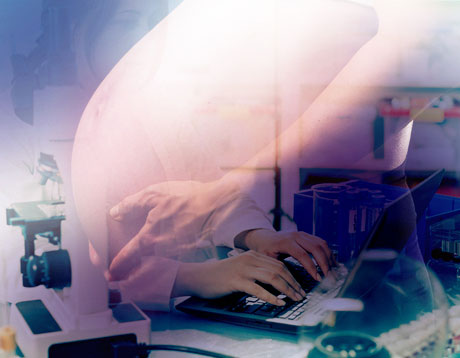Understanding the Mechanics of Tissues
Understanding the Mechanics of Tissues


Kristin Myers is a traditionally trained mechanical engineer, conducting a battery of mechanical tests to understand the capacity of materials to withstand loads. But the materials she is working with are far from the metals and other hard materials mechanical engineers typically work with.
When the mechanical engineering professor at Columbia University’s school of engineering is in her lab, she is “poking and prodding” soft tissues of the human body, mainly female reproductive organs, more specifically the cervix.
“When I tell people I’m a mechanical engineering professor, they think cars or airplanes or bridges. I can work on those things too,” she says. “That’s how I see pregnancy. You know, if the structure’s weak it will fail. And if there is a defect, you will have a catastrophic failure. It sometimes sounds horrible because I simplify things down to basic units like there’s a load on the structure, and if the structure fails, the structure will fall through. That’s how engineers think.”
Myers is investigating the mechanical behavior of tissues to gain a better understanding of how tissue architecture affects body behavior to aid in early diagnosis and treatment of disease and other conditions. She is focused mainly on the cervix to learn more about prematurity and pre-term birth.
Her work with the reproductive system she is trying to learn “how can we help the clinician better assess if a woman is going to have a pre-term birth, and how can we help prevent those from happening,” she says.
A native of Detroit with family and friends in the automotive industry, she actually thought she was on track to follow suit. She loved cars and loved her mechanical engineering classes at the University of Michigan. She spent several summers as an intern at General Motors. But one summer, she thought she should try something else and joined a professor’s lab, looking at the mechanical properties of soft polymers and elastomers. “That’s how I got involved in academic engineering and wanting to become a professor,” she says.
When she began searching for a graduate program, she wanted a research lab opportunity in the up-and-coming area of biomechanics where she could use her traditional mechanical engineering skills. She found Simona Socrate, an assistant professor at MIT who was starting a new project in pregnancy biomechanics. Myers recalls, “That was totally different from anything I had ever heard of. I thought that was really cool that I could use my skills as a mechanical engineer who studies structures and materials and the mechanical properties of solids to do that.”
Myers had just won a National Science Foundation graduate research fellowship and decided to use the money for that at MIT, collaborating with Socrate. “There are just no data on the mechanical properties of various tissues in the female reproductive system,” she says. “For orthopedic and cardiovascular biomechanics, there were hundreds of articles on the material properties of bone or cartilage or tendon. These material properties [of the female reproductive system] are really important because the tissues support the growing fetus and keep it safe and then at the appropriate time they have to deliver the baby safely.”
It involves a lot of interaction between biological processes and the material properties of the uterus, cervix, and fetal membrane. “We want to relate all of these things,” she says. She remained at MIT for her doctorate and did post-doctoral research at Johns Hopkins University before joining the Columbia University engineering faculty and opening her lab in 2010.
Working closely with clinicians and molecular biologists, she and the four doctoral students in her lab approach the work in two different ways: animal studies with mice and human studies that have involved building a computer model of the pregnant abdomen to simulate forces of pregnancy using information from a woman’s ultrasound imagery.
“My main goal with the computer models is to be able to identify if there is some sort of unfavorable mechanical environment for pregnancy. We hypothesize that women who have tissue that stretches too much will deliver pre-term because women who have a higher number of gestations, like twins, typically deliver pre-term. We just want to understand the mechanical factors that drive it,” she says.
With the model, she will be able to calculate how fiber-based composite materials the team has identified are going to hold the loads (the fetus) in. “We can ask the model various what-if scenarios,” she says. “What if my uterus is stronger than my cervix or what if my cervix is too weak? What if we apply a biomedical device to hold the cervix in place? Or can we place it better somehow?”
In the animal work, the team recently published a paper on how the material properties of the cervix in a mouse changed during gestation. “The next step is to test what happens if the tissue gets inflamed with infection, what happens to the tissue if we apply different hormonal stimuli,” she says.
Myers says her work is extremely rewarding. “There is no current model to show how a pregnancy is going to progress. There are so many questions surrounding pregnancy,” she says. Myers wants to come up with a tool that can answer some of those questions to help put a woman’s mind at ease and to prevent preterm birth.
Nancy S. Giges is an independent writer.
Learn about the latest trends in bioengineering at ASME’sNEMBConference.
There is no current model to show how a pregnancy is going to progress. There are so many questions surrounding pregnancy.Prof. Kristin Myers, Columbia University





